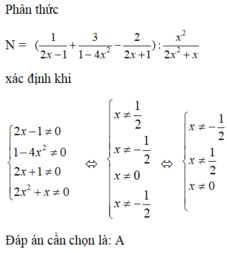Cho biểu thức N = . Với giá trị nào của x thì N xác định
Hãy nhập câu hỏi của bạn vào đây, nếu là tài khoản VIP, bạn sẽ được ưu tiên trả lời.



1,
\(A=\dfrac{4x^2}{\left(x-2\right)\left(x+2\right)}+\dfrac{x-2}{\left(x-2\right)\left(x+2\right)}-\dfrac{x+2}{\left(x-2\right)\left(x+2\right)}\)
\(=\dfrac{4x^2+x-2-\left(x+2\right)}{\left(x-2\right)\left(x+2\right)}=\dfrac{4x^2-4}{\left(x-2\right)\left(x+2\right)}\)
\(x=4\Rightarrow A=\dfrac{4.x^2-4}{\left(4-2\right)\left(4+2\right)}=...\)
2.
\(A=\dfrac{x\left(x+1\right)}{\left(x-1\right)\left(x+1\right)}+\dfrac{3\left(x-1\right)}{\left(x-1\right)\left(x+1\right)}+\dfrac{3-5x}{\left(x-1\right)\left(x+1\right)}\)
\(=\dfrac{x\left(x+1\right)+3\left(x-1\right)+3-5x}{\left(x-1\right)\left(x+1\right)}=\dfrac{x^2-2x+1}{\left(x-1\right)\left(x+1\right)}\)
\(=\dfrac{\left(x-1\right)^2}{\left(x-1\right)\left(x+1\right)}=\dfrac{x-1}{x+1}\)
3.
Đề lỗi, thiếu dấu trước \(\dfrac{6+5x}{4-x^2}\)
4.
\(A=\dfrac{2x}{\left(x-5\right)\left(x+5\right)}-\dfrac{5\left(x+5\right)}{\left(x-5\right)\left(x+5\right)}-\dfrac{x-5}{\left(x-5\right)\left(x+5\right)}\)
\(=\dfrac{2x-5\left(x+5\right)-\left(x-5\right)}{\left(x-5\right)\left(x+5\right)}=\dfrac{-4x-20}{\left(x-5\right)\left(x+5\right)}\)
\(=\dfrac{-4\left(x+5\right)}{\left(x-5\right)\left(x+5\right)}=\dfrac{-4}{x-5}\)
\(x=\dfrac{4}{5}\Rightarrow A=\dfrac{-4}{\dfrac{4}{5}-5}=\dfrac{20}{21}\)
5.
\(M=\dfrac{x^2}{x\left(x+2\right)}+\dfrac{2x}{x\left(x+2\right)}+\dfrac{2\left(x+2\right)}{x\left(x+2\right)}\)
\(=\dfrac{x^2+2x+2\left(x+2\right)}{x\left(x+2\right)}=\dfrac{x^2+4x+4}{x\left(x+2\right)}\)
\(=\dfrac{\left(x+2\right)^2}{x\left(x+2\right)}=\dfrac{x+2}{x}\)
\(x=-\dfrac{3}{2}\Rightarrow M=\dfrac{-\dfrac{3}{2}+2}{-\dfrac{3}{2}}=-\dfrac{1}{3}\)

Bài 1:
a: \(A=\dfrac{x^2-3+x+3}{\left(x-3\right)\left(x+3\right)}\cdot\dfrac{x+3}{x}=\dfrac{x\left(x+1\right)}{x\left(x-3\right)}=\dfrac{x+1}{x-3}\)
b: Để A=3 thì 3x-9=x+1
=>2x=10
hay x=5
Bài 2:
a: \(A=\dfrac{x+x-2-2x-4}{\left(x-2\right)\left(x+2\right)}:\dfrac{x+2-x}{x+2}\)
\(=\dfrac{-6}{x-2}\cdot\dfrac{1}{2}=\dfrac{-3}{x-2}\)
b: Để A nguyên thì \(x-2\in\left\{1;-1;3;-3\right\}\)
hay \(x\in\left\{3;1;5;-1\right\}\)

Bài 1.
a)\(\frac{4x-4}{x^2-4x+4}\div\frac{x^2-1}{\left(2-x\right)^2}=\frac{4\left(x-1\right)}{\left(x-2\right)^2}\div\frac{\left(x-1\right)\left(x+1\right)}{\left(x-2\right)^2}=\frac{4\left(x-1\right)}{\left(x-2\right)^2}\times\frac{\left(x-2\right)^2}{\left(x-1\right)\left(x+1\right)}=\frac{4}{x+1}\)
b) \(\frac{2x+1}{2x^2-x}+\frac{32x^2}{1-4x^2}+\frac{1-2x}{2x^2+x}=\frac{2x+1}{x\left(2x-1\right)}+\frac{-32x^2}{4x^2-1}+\frac{1-2x}{x\left(2x+1\right)}\)
\(=\frac{\left(2x+1\right)\left(2x+1\right)}{x\left(2x-1\right)\left(2x+1\right)}+\frac{-32x^3}{x\left(2x-1\right)\left(2x+1\right)}+\frac{\left(1-2x\right)\left(2x-1\right)}{x\left(2x-1\right)\left(2x+1\right)}\)
\(=\frac{4x^2+4x+1}{x\left(2x-1\right)\left(2x+1\right)}+\frac{-32x^3}{x\left(2x-1\right)\left(2x+1\right)}+\frac{-4x^2+4x-1}{x\left(2x-1\right)\left(2x+1\right)}\)
\(=\frac{4x^2+4x+1-32x^3-4x^2+4x-1}{x\left(2x-1\right)\left(2x+1\right)}=\frac{-32x^3+8x}{x\left(2x-1\right)\left(2x+1\right)}\)
\(=\frac{-8x\left(4x^2-1\right)}{x\left(2x-1\right)\left(2x+1\right)}=\frac{-8x\left(2x-1\right)\left(2x+1\right)}{x\left(2x-1\right)\left(2x+1\right)}=-8\)
c) \(\left(\frac{1}{x+1}+\frac{1}{x-1}-\frac{2x}{1-x^2}\right)\times\frac{x-1}{4x}\)
\(=\left(\frac{1}{x+1}+\frac{1}{x-1}+\frac{2x}{x^2-1}\right)\times\frac{x-1}{4x}\)
\(=\left(\frac{x-1}{\left(x-1\right)\left(x+1\right)}+\frac{x+1}{\left(x-1\right)\left(x+1\right)}+\frac{2x}{\left(x-1\right)\left(x+1\right)}\right)\times\frac{x-1}{4x}\)
\(=\left(\frac{x-1+x+1+2x}{\left(x-1\right)\left(x+1\right)}\right)\times\frac{x-1}{4x}\)
\(=\frac{4x}{\left(x-1\right)\left(x+1\right)}\times\frac{x-1}{4x}=\frac{1}{x+1}\)
Bài 3.
N = ( 4x + 3 )2 - 2x( x + 6 ) - 5( x - 2 )( x + 2 )
= 16x2 + 24x + 9 - 2x2 - 12x - 5( x2 - 4 )
= 14x2 + 12x + 9 - 5x2 + 20
= 9x2 + 12x + 29
= 9( x2 + 4/3x + 4/9 ) + 25
= 9( x + 2/3 )2 + 25 ≥ 25 > 0 ∀ x
=> đpcm

a: \(A=\left(\dfrac{2x^2+2}{x^3-1}+\dfrac{x^2-x+1}{x^4+x^2+1}-\dfrac{x^2+3}{x^3-x^2+3x-3}\right):\dfrac{1}{x-1}\)
\(=\left(\dfrac{2x^2+2}{\left(x-1\right)\left(x^2+x+1\right)}+\dfrac{x^2-x+1}{x^4+2x^2+1-x^2}-\dfrac{x^2+3}{x^2\left(x-1\right)+3\left(x-1\right)}\right)\cdot\dfrac{x-1}{1}\)
\(=\left(\dfrac{2x^2+2}{\left(x-1\right)\left(x^2+x+1\right)}+\dfrac{\left(x^2-x+1\right)}{\left(x^2+1\right)^2-x^2}-\dfrac{x^2+3}{\left(x-1\right)\left(x^2+3\right)}\right)\cdot\dfrac{x-1}{1}\)
\(=\left(\dfrac{2x^2+3}{\left(x-1\right)\left(x^2+x+1\right)}+\dfrac{x^2-x+1}{\left(x^2+1+x\right)\left(x^2+1-x\right)}-\dfrac{1}{x-1}\right)\cdot\dfrac{x-1}{1}\)
\(=\left(\dfrac{2x^2+3}{\left(x-1\right)\left(x^2+x+1\right)}+\dfrac{1}{x^2+x+1}-\dfrac{1}{x-1}\right)\cdot\dfrac{x-1}{1}\)
\(=\dfrac{2x^2+3+x-1-x^2-x-1}{\left(x-1\right)\left(x^2+x+1\right)}\cdot\dfrac{x-1}{1}\)
\(=\dfrac{x^2+1}{x^2+x+1}\)
b: Để A là số nguyên thì \(x^2+1⋮x^2+x+1\)
=>\(x^2+x+1-x⋮x^2+x+1\)
=>\(x⋮x^2+x+1\)
=>\(x^2+x⋮x^2+x+1\)
=>\(x^2+x+1-1⋮x^2+x+1\)
=>\(-1⋮x^2+x+1\)
=>\(x^2+x+1\in\left\{1;-1\right\}\)
=>\(x^2+x+1=1\)
=>x2+x=0
=>x(x+1)=0
=>\(x\in\left\{0;-1\right\}\)

a) Các biểu thức: \(\dfrac{1}{5}x{y^2}{z^3}; - \dfrac{3}{2}{x^4}{\rm{yx}}{{\rm{z}}^2}\) là đơn thức
b) Các biểu thức: \(2 - x + y; - 5{{\rm{x}}^2}y{z^3} + \dfrac{1}{3}x{y^2}z + x + 1\) là đa thức

Bài 1.
a) ( x - 2)2 - ( x + 3)( x - 3)= 17
=> x2 - 4x + 4 - x2 + 9 - 17 = 0
=> -4x - 4 = 0
=> -4( x + 1 ) = 0
=> x = -1
Vậy,...
b)4( x - 3)2 - ( 2x - 1)( 2x + 1) = 10
=> 4( x2 - 6x + 9) - 4x2 + 1 - 10 = 0
=> - 24x + 36 - 9 = 0
=> -24x + 27 = 0
=> -3( 8x - 9) = 0
=> x = \(\dfrac{9}{8}\)
Vậy,...
c) ( x - 4)2 - ( x - 2)( x + 2)= 36
=> x2 - 8x + 16 - x2 + 4 - 36 = 0
=> -8x - 16 = 0
=> -8( x + 2) = 0
=> x = -2
d) ( 2x + 3)2 - ( 2x + 1)( 2x - 1) = 10
=> 4x2 + 12x + 9 - 4x2 + 1 - 10 = 0
=> 12x = 0
=> x = 0
Vậy,...
Bài 2.
\(\dfrac{3x^2+3x}{\left(x+1\right)\left(2x-6\right)}\)
a) ĐKXĐ : ( x + 1)( 2x - 6) # 0
=> 2( x + 1)( x - 3) # 0
=> x # -1 ; x # 3
Vậy,...
b) Để P = 1
=> \(\dfrac{3x^2+3x}{\left(x+1\right)\left(2x-6\right)}=1\)
=> \(\dfrac{3x\left(x+1\right)}{2\left(x+1\right)\left(x-3\right)}=\dfrac{3x}{2\left(x-3\right)}=1\)
=> 3x = 2x - 6
=> x = -6 ( thỏa mãn ĐKXĐ)
Vậy,...
Bài 3.
P = \(\dfrac{x}{x-1}+\dfrac{x^2+1}{1-x^2}\)
a) Để P có nghĩa tức P xác định .
ĐKXĐ : x - 1 # 0 => x # 1
* 1 - x2 # 0 => x # 1 ; x # -1
Vậy,...
b) P = \(\dfrac{x}{x-1}+\dfrac{x^2+1}{1-x^2}\)
P = \(\dfrac{x^2+x-x^2-1}{\left(x-1\right)\left(x+1\right)}=\dfrac{x-1}{\left(x-1\right)\left(x+1\right)}=\dfrac{1}{x+1}\)( x# 1; x# -1)
c) Để P = -1 thì :
\(\dfrac{1}{x+1}=-1\)
=> -x - 1 = 1
=> x = -2 ( thỏa mãn ĐKXĐ )
Vậy,...